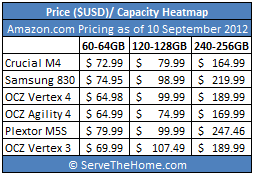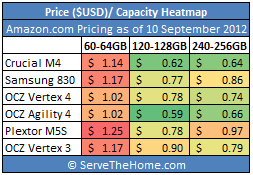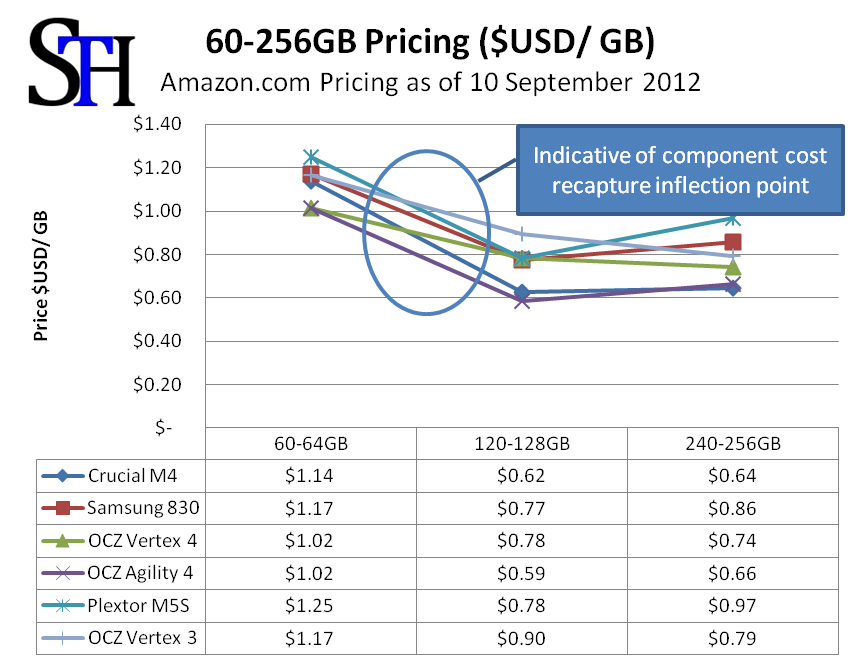We watch SSD pricing fairly regularly at ServeTheHome. When SSDs were newer technology, a 60GB to 64GB SSD was enough to install an operating system and a few programs, making it a lower cost boot drive option when prices were $1.50 to $2/ GB. These days, larger capacity drives are well under $1/GB so we are something similar to what happened about a year ago. 12-18 months ago the 30GB to 32GB drives went through a similar shake-out when their pricing got too close to the 64GB drives. Today, and in a similar fashion, a 64GB SSD can be seen getting incrementally closer to 128GB SSD pricing. To see these market forces in action, SanDisk released their popular Sandisk Extreme line fairly recently, and capacities start at 120GB.
Why 64GB SSD Pricing is so High
One of the biggest drivers in the high relative $/GB pricing we are seeing with each brand’s 60GB and 64GB SSD offerings are fixed cost components of the BOM and SG&A.
Looking at fixed portions of the BOM first, we can see the reasons for the skew in lower capacity SSD pricing. When we talk about drive capacities, we usually see two main differences in the physical product, RAM and NAND capacities. The rest of the physical product, including the packaging, PCB, controller and miscellaneous electrical components are generally the same between models. Assembly costs are going to be similar as are general SG&A costs. This is the same type of analysis that can be used on hard drives.
The quick way to think about it, is that you have two main parts. A semi-fixed cost for common bits and a variable cost for the onboard memory. When you increase capacity, fixed costs are spread over a larger denominator. As a result, cost per gigabyte goes down.
When looking at modern 64GB SSD prices, it is becoming clear that the 64GB SSD capacity price is being largely driven by this fixed portion.
Comparing 64GB SSD and Larger Capacity Cost Curves
After having seen this pattern for years in hard drives, memory and elsewhere, we now see this in the world of solid state drives. The 32GB SSD capacity is not used as much anymore. Here is a quick comparison of a few popular drive prices as of 10 September 2012:

Take note of the 64GB SSD pricing as compared to the 128GB drive pricing. You will note that they are very similar. At the very least, moving to twice the 64GB SSD capacity does not cost anywhere near twice as much. Likewise, moving to four times the base 64GB SSD capacity does not yield four times the cost when looking at 256GB drives. One can note that the Crucial M4 pricing on Amazon is very similar between the Crucial M4 64GB SSD and Crucial M4 128GB SSD. Also take note that the Agility 4 64GB SSD was actually the same after rebate price as the 128GB SSD version. All prices did not include rebates.
Breaking this down by usable capacity, here is a price per GB heat map. The heat map compares $USD/ Usable GB for the 64GB SSD selections versus 128GB and 256GB SSD variants of the same drives.

Here one can see that the Crucial M4 and OCZ Agility 4 drives are leaders in the price per GB area. The heat map shows that if your purchase a 64GB SSD, you are likely going to pay slightly above $1. On the other hand, moving to larger drives means lower costs per GB.

This visual comparison really shows the recapture costs of shared components in a stark manner. The 60GB and 64GB SSD to 128GB SSD drop is very steep. One other interesting feature of the graph is that you can see the different pricing strategies when looking at larger drives. The OCZ Vertex 4 and Vertex 3 drives have lower cost per GB points at 256GB than their 128GB counterparts. Other drives saw larger capacities actually see price premiums over the 128GB SSD parts. That is an interesting note especially as the OCZ Agility 4 shows a price premium for the larger capacity.
Conclusion
This was just a short post showing the tell tale pricing signs of a capacity shift. The 64GB SSD capacity is seeing its pricing dominated by parts on the bill of materials other than the NAND. SanDisk did not even release a 64GB version of the SanDisk Extreme SSD. Finally, most benchmarks will show that a 64GB SSD will under perform versus 128GB and 256GB capacities. Especially looking at the Crucial M4 pricing today, one would be almost crazy not to spend the $7 to get double the capacity for less than a 10% price premium. It is a good thing that drives are again shifting in minimum capacities as 128GB does provide for significantly more room than a 64GB SSD.
Note: Amazon changes prices dynamically. As a result, pricing will change from the values above up or down by a few dollars, but the price trend is clear.




Haven’t ever seen this type of analysis before. Real problem is that 64GB is useless in a single drive system. By the time I have windows and a few apps on the drive, I run out of space trying to do big (1gb and bigger) updates. 120gig is the bare minimum.